

High Resolution Image

Obverse
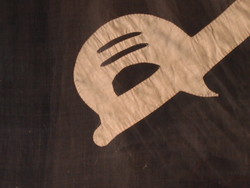
Detail
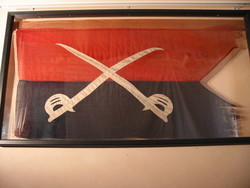
Framed View
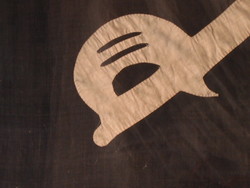
Hilt detail

Lower Fly
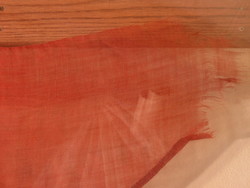
Upper Fly
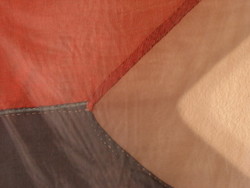
Swallow Tail Center

Upper Hoist
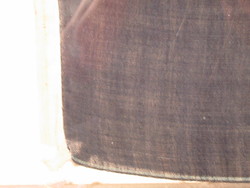
Lower Hoist
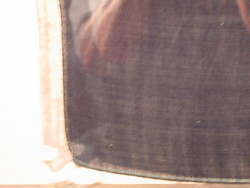
Lower Hoist - 2
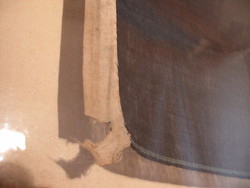
Lower Hoist Damage
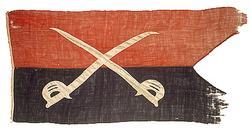
Book Photo
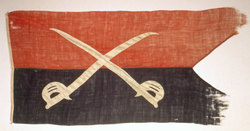
Obverse - 2
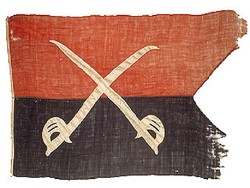
Obverse - edit
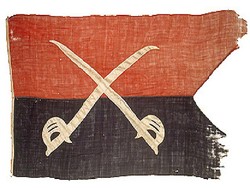
Obverse - edit 2
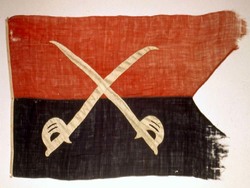
Obverse - edit 3

Echoes of Glory P.289.

US Army Designating Flags 1887
Gen. George A. Custer's Third Personal Guidon.
Sub-collection: General George A. Custer
General George A. Custer wearing a double breasted jacket that he designed and had tailor-made for himself in the Autumn of 1863.
General George A. Custer's Third Personal Civil War Cavalry Guidon.
This flag was handmade by the wife of General Custer, Libby Custer, in 1864. This flag was only flown when Custer was on the field. This was one of Custer's more famous flags, as it served with him in the Civil War while commanding the US 3rd Cavalry Division from 1864-65. After the war, it was sent to his home in Monroe, Michigan. Upon his death at the Little Big Horn, it was given by Libby to his brother, Nevin, who kept it in the family until it was sold at auction 130 years later.
There is a companion flag, the 3rd Calvary Division guidon that served with this guidon. The two guidons were always with Custer when he was on the field. After the war, the guidons were sent to Custer's home in Monroe, Michigan, where they stayed until his death in 1876. After the Little Big Horn battle, his wife Libby gave the two flags to his brother (personal guidon) and sister (3rd Div.), separating the flags for 130 years until they were reunited at auction.

Major General George A. Custer's Headquarters with his two guidons, Winchester, Virginia, December 25, 1864.
The field is formed in the design of a swallowtail guidon, composed of two horizontal wool/bunting bars, the upper red and the lower dark blue. Appliquéd by hand to both sides in white cotton are two crossed sabers, unsheathed and edges up, 37 1/2" long overall. A white cotton heading, 3/4" wide has been sewn to the leading edge and bears three hand sewn button hole eyelets.
Exhibition History:
Inventing Custer: Legends of the Little Big Horn
25 May 1996 to 2 September 1996
The Autry National Center
4700 Western Heritage Way
Griffith Park
Los Angeles, CA
Buffalo Bill Historic Center,
Cody, Wyoming.
First Presidio Exhibit
(ZFC0489)
General George Armstrong Custer's Third Personal Cavalry Headquarters Guidon
Second Presidio Exhibit, 2003 - Gallery III
(ZFC0489)
General George A. Custer's Third Personal Cavalry Headquarters Guidon
Private Showing
11 November 2008
Tiger 21 Meeting, Muir Room
Four Seasons Hotel, San Francisco, CA
University of California - Santa Cruz
Board of Councilors Meeting, Rare Flags Exhibit
Santa Cruz, CA
7 June 2012
ZFC Significant Flag
Item is Framed
Publication History
Wright, Horatio, editor, Flags of the Army of the United States Carried During The War of the Rebellion 1861-1865, To Designate the Headquarters of the different Armies, Army Corps, Divisions and Brigades, or "Designating Flags of the United States Army, 1861-1865", Philadelphia, Burk & McFetridge, 1887/1888. P. Gen Custer's Flags.
Katz, D. Mark, Custer in Photographs, New York, Bonanza Books, 1985. P 35.
Merington, Marguerite, editor, The Custer Story: The Life and Intimate Letters of General George A. Custer, University of Nebraska Press, Lincoln,1987, pp. 140-141 7 147-148.
Woodhead, Henry, Editor, Howard Michael Madaus, Civil War Flag Authority Echoes of Glory: Arms and Equipment of The Union - Flags. Alexandria, Time-Life Books, 1998. P. 289.
Madaus, Howard M.- Whitney Smith, The American Flag: Two Centuries of Concord and Conflict, VZ Publications, Santa Cruz, 2006. pp. 86-87.
Schrambling, Regina, "A Lifelong Pledge." Collection, Published by Robb Report, June 2014, p. 48H.
Provenance:
• Elizabeth "Libbie" Custer: Flag Hand-sewn in summer of 1864, and used by General Custer until Dinwiddie Court House, Virginia on March 31, 1865.
• Retained by General George Armstrong Custer.
• Retained by Lt. Colonel (Brevet Major General) G.A. Custer until passing, 1876.
• By descent in the Nevin Custer family to G.A. Custer nephew Charles Custer and thence to grand nephew Richard Custer, Monterey, CA, until 1995.
• Sold via Butterfield & Butterfield Auction House of San Francisco, CA, to the Zaricor Flag Collection, 1995.
Sources:
Wright, Horatio, editor, Flags of the Army of the United States Carried During The War of the Rebellion 1861-1865, To Designate the Headquarters of the different Armies, Army Corps, Divisions and Brigades, or "Designating Flags of the United States Army, 1861-1865", Philadelphia, Burk & McFetridge, 1887/1888. P. Gen Custer's Flags.
Merington, Marguerite, editor, The Custer Story: The Life and Intimate Letters of General George A. Custer, University of Nebraska Press, Lincoln,1987, pp. 339.
Madaus, Howard M.- Whitney Smith, The American Flag: Two Centuries of Concord and Conflict, VZ Publications, Santa Cruz, 2006.
Madaus, H. Michael, The Personal and Designating Flags of General George A. Custer, 1863 - 1865, Spring 1968, Military Collector and Historian, Washington, DC.
Howard M. Madaus, C.W. Vexillological Services, Cody Wyoming, to Mr. Ben Zaricor, Santa Cruz, CA, 290 April 1995, Zaricor Flag Collection Archives.
Davis, John, Custer - General's Grandnephew shares Views, Profile, Las Cruces Sun News, Sunday August 17, 1975, Las Cruces, New Mexico.
Woodhead, Henry, ed., Flags, Echoes of Glory: Arms and Equipment of The Union, New York, Time Life Books, 1998.
General Custer's Headquarters Flag (U.S.), Flags of the World, 3 November 2011, from: http://www.crwflags.com/fotw/flags/us%5Ecstr.html
Image Credits
Zaricor Flag Collection
Hoist & Fly | |
|---|---|
| Width of Hoist | 32 |
| Length of Fly | 73 |
Stripes | |
|---|---|
| Width of 1st Stripe | 16 |
| Width of Last Stripe | 16 |
| Size of Hoist | 2 |
Frame | |
|---|---|
| Is it framed? | yes |
| Frame Height | 39 |
| Frame Length | 74 |
Stars | |
|---|---|
| Are there stars on obverse? | no |
| Are there stars on reverse? | no |
Stripes | |
|---|---|
| Number of Stripes | 2 |
| Color of Top Stripe | Red |
| Color of Bottom Stripe | Blue |
| Has a Blood Stripe? | no |
Crest/Emblem | |
|---|---|
| Description of Crest/Emblem | Two uncovered stylized cavalry sabers, crossed, blade up. |
Nationality | |
|---|---|
| Nation Represented | United States |
Fabric | |
|---|---|
| Fabric | Wool |
| Comments on Fabric | cotton sabers |
Stitching | |
|---|---|
| Stitching | Hand |
Weave | |
|---|---|
| Type of Weave | Plain |
Attachment | |
|---|---|
| Method of Attachment | Sleeve |
Applica | |
|---|---|
| Applique Sides | Single Faced = Mirror Image Reverse |
Documentation | |
|---|---|
| Documents | |
| Drawings | |
| Research Documents | |
| Public Copy & Signs | |
| Press | |
Condition | |
|---|---|
| Condition | Excellent |
| Damage | Flag is used, worn with some fabric loss from the fly tips. |
| Displayable | yes |
Date | |
|---|---|
| Date | 1864 |
Exhibits | |
|---|---|
| Exhibition Copy | The Autry National Center of the American West, Los Angeles, CA Buffalo Bill Historic Center, Cody, Wyoming. First Presidio Exhibit (ZFC0489) GENERAL GEORGE ARMSTRONG CUSTERS THIRD PERSONAL CAVALRY HEADQUARTERS GUIDON Second Presidio Exhibit, 2003 - Gallery III (ZFC0489) General George A. Custers Third Personal Cavalry Headquarters Guidon Exhibition History Private Showing 11 November 2008 Tiger 21 Meeting, Muir Room Four Seasons Hotel, San Francisco, CA Exhibition History First Presidio Exhibit (ZFC0489) GENERAL GEORGE ARMSTRONG CUSTERS THIRD PERSONAL CAVALRY HEADQUARTERS GUIDON Date: 1864 Media: Wool bunting with cotton crossed sabers; all hand sewn Comment: Shortly after Custer received his commission as a Brigadier-General and closely following the battle of Gettysburg, George Armstrong Custer caused to be made a swallowtail guidon, divided horizontally, red over blue, with white sabers crossing, as his personal guidon to mark his location in the field of battle and in camp. The first made was crude, but it was replaced in the Winter of 1863-1864 by an elaborate flag of the same design but made of silk, fringed, and decorated with battle honors from Custers 1863 service. In June of 1864, this second personal flag was nearly captured and was saved only by tearing it from its staff. As it was too damaged in the process for further use, in the summer of 1864, Custer commissioned yet a third example of his personal flag. This is that flag. Custers third personal flag was carried by him through the remaining campaigns of 1864, including the Shenandoah Valley Campaign, where Custer was photographed with it (and his 3rd Division guidon) in front of his headquarters. It also started with him on the spring, 1865 campaign south of Petersburg, and was only replaced by another fine silk example crafted by his wife, Libbie as Custer began the final battles on April 1st, 1865 that culminated at Appomattox Court House in April 9th, 1865. Provenance: Acquired by the Zaricor Flag Collection (ZFC0489) in 1995 from the descendants of G. A. Custer through auction by Butterfield & Butterfield Auction House of San Francisco, CA. Second Presidio Exhibit, 2003 - Gallery III (ZFC0489) General George A. Custers Third Personal Cavalry Headquarters Guidon Date: 1864 Media: Wool bunting with cotton crossed sabers; all hand-sewn Comment: Shortly after receiving his commission as a brigadier-general and closely following the Battle of Gettysburg, George Armstrong Custer caused to be made a swallowtailed guidon, divided horizontally red over blue with white crossed sabers. This served as his personal guidon to mark his location in the field of battle and in camp. The first one was crude, but it was replaced in the Winter of 1863-1864 by an elaborate flag of the same design made of silk, fringed, and decorated with battle honors from Custers 1863 service. In June 1864 this second personal flag was nearly captured; it was saved only by tearing it from its staff. As it was too damaged in the process for further use, in the Summer of 1864 Custer commissioned yet a third example of his personal flag. This is that very flag. Custers third personal flag was carried by him through the remaining campaigns of 1864, including the Shenandoah Valley campaign, where Custer was photographed with it (and his 3rd Division guidon) in front of his headquarters. It also started with him on the Spring 1865 campaign south of Petersburg and was only replaced by another fine silk example crafted by his wife, Libbie, as Custer began the final battles on April 1, 1865, that culminated at Appomattox Court House in April 9, 1865. Provenance: Acquired by the Zaricor Flag Collection (ZFC0489) in 1995 from the descendants of G. A. Custer through auction by Butterfield & Butterfield Auction House of San Francisco, CA. Exhibition History Private Showing 11 November 2008 Tiger 21 Meeting, Muir Room Four Seasons Hotel, San Francisco, CA University of California - Santa Cruz Board of Councilors Meeting, 7 June 2012 Rare Flags Exhibit Santa Cruz, CA, June 7, 2012: The Zaricor Flag Collection exhibited 34 flags and artifacts at the University of California Santa Cruz Campus for the Board of Councilors Meeting. General George A. Custer's Third Personal Cavalry Headquarters Guidon Date: 1864 Media: Wool bunting with cotton crossed sabers; all hand-sewn. Comment: Shortly after receiving his commission as a brigadier-general and closely following the Battle of Gettysburg, George Armstrong Custer caused to be made a swallow-tailed guidon, divided horizontally red over blue with white crossed sabers. This served as his personal guidon to mark his location in the field of battle and in camp. The first one was crude, but it was replaced in the winter of 1863-1864 by an elaborate flag of the same design made of silk, fringed, and decorated with battle honors from Custer's 1863 service. In June 1864 this second personal flag was nearly captured; it was saved only by tearing it from its staff. As it was too damaged in the process for further use, in the summer of 1864 Custer commissioned yet a third example of his personal flag. This is that very flag. Custer's third personal flag was carried by him through the remaining campaigns of 1864, including the Shenandoah Valley campaign, where Custer was photographed with it (and his 3rd Division guidon) in front of his headquarters. It also started with him on the spring 1865 campaign south of Petersburg and was only replaced by another fine silk example crafted by his wife, Libbie, as Custer began the final battles on April 1, 1865, that culminated at Appomattox Court House in April 9, 1865. Provenance: Acquired by the Zaricor Flag Collection (ZFC0489) in 1995 from the descendants of G. A. Custer through auction by Butterfield & Butterfield Auction House of San Francisco, CA. www.FlagCollection.com |
Publications | |
|---|---|
| Publication Copy | Publication History: Katz, D. Mark, Custer in Photographs, New York, Bonanza Books, 1985. P. 35 Woodhead, Henry, Editor, Howard Michael Madaus, Civil War Flag Authority Echoes of Glory: Arms and Equipment of The Union - Flags. Alexandria, Time-Life Books, 1998. P. 289. (See Images below). Madaus, Howard M., Dr, Whitney Smith, The American Flag: Two Centuries of Concord and Conflict. Santa Cruz: VZ Publications, 2006, p. 86-87. General George A. Custers Third Personal Cavalry Headquarters Guidon Shortly after receiving his commission as a brigadier general and closely following the Battle of Gettysburg, George Armstrong Custer caused to be made a swallowtailed guidon, divided horizontally red over blue with white crossed sabers. This served as his personal guidon to mark his location in the field of battle and in camp. The first one was crude, but it was replaced in the Winter of 1863 1864 by an elaborate flag of the same design made of silk, fringed, and decorated with battle honors from Custers 1863 service. In June 1864 this second personal flag was nearly captured; it was saved only by tearing it from its staff. As it was too damaged in the process for further use, in the Summer of 1864 Custers wife made yet a third personal flag, which was his most famous. This is that very flag. Custers third personal flag was carried by him through the remaining campaigns of 1864, including the Shenandoah Valley campaign, where Custer was photographed with it, and his 3rd Division guidon, in front of his headquarters. It also started with him on the Spring 1865 campaign south of Petersburg and was only replaced by another fine silk example, crafted by his wife, Libbie, as Custer began the final battles on April 1, 1865, that culminated at Appomattox Court House in April 9, 1865. Date: 1864 Size: 32" hoist x 73" fly Media: Wool bunting with cotton crossed sabers; all hand-sewn Provenance: Acquired by the Zaricor Flag Collection in 1995 from the descendants of G. A. Custer, through Butterfield & Butterfield Auction House of San Francisco, CA. ZFC0489 |
| Publication Images | |

































































































